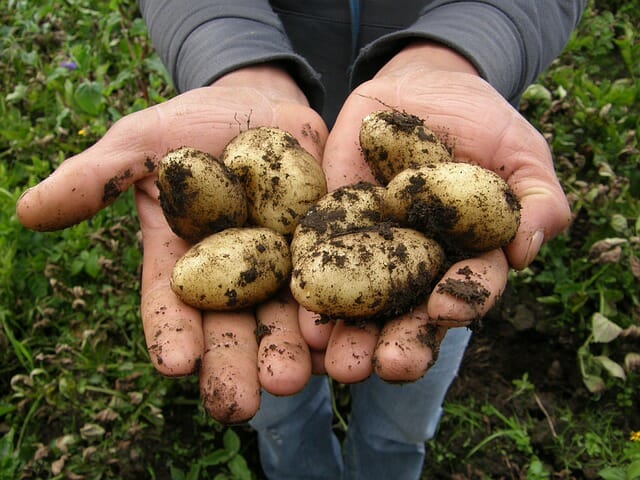Extending the shelf life of root vegetables like potatoes has been practiced for centuries as a method to enjoy the harvest year-round. Traditionally, potatoes grown for storage are a variety bred specifically for winter storage, since not all varieties keep well long-term. Thicker-skinned potatoes such as russets will store far longer than thin-skinned red potatoes.
The traditional method of winter storage is by using a root cellar. Harvesting them is to dig the potatoes when the potato plants have died down. Then, brush off dirt (without washing) and cure them before storage. Curing the potatoes in temperatures ranging from 45-60 degrees Fahrenheit (or as high as 80-85 for sweet potatoes) and high humidity (90 percent or more) gives potatoes a thicker skin that prolongs their storage life and lessens spoilage.
Potatoes Prefer Shade
The curing process should occur in the shade or in a darkened indoor location like a barn. If your potatoes are green, it means they have been exposed to excessive light and should be discarded. The green color is frequently a sign that solamine is present. Unfortunately, solamine is toxic at high levels.
Store potatoes in a humid dark root cellar at approximately 45 degrees Fahrenheit after curing them. Potatoes should be packed in bushel baskets or burlap sacks or in several piles. Storage temperatures below 45 degree Fahrenheit may increase the sugar content of potatoes. However, higher temperatures can lead to shrinkage or rot, reducing storage life by half. Also, potatoes should be stored away from any fruit that gives off ethylene gas (such as apples and pears). Frequently, people will wrap apples and pears individually in paper to store them in a root cellar so as to reduce the ethylene gas they emit.
Top Secret Food Storage Advice Found Here
Storing for 20 Years
Twenty years sounds like a long time to store potatoes. Surprisingly, “fresh” potatoes in the grocery store are often 11 months old when you buy them. Modern developments in commercial food storage allow growers to store produce with a chemical (1-methylcyclopropene), which extends the shelf life of vegetables.
Of course, fresh potatoes won’t last 20 years, but you can dehydrate them to get that kind of long-term shelf life while maintaining nutritional value.
Some conditions:
1) The shelf life will be longer if your storage location has a moderate temperature and reduced light. Therefore, a cool basement would be ideal, while a hot attic or room which fluctuates in temperature will shorten the shelf life of any stored food.
2) Botulism can grow in low-oxygen moist environments. To avoid this, you must reduce the moisture level within the potatoes to 10 percent or less in order to store long-term with an oxygen absorber packet or to safely store using a vacuum sealer that removes air.
Pocket Sized Solar Generator System Provides Endless Backup Power
Here’s how to do it:
- A dehydrator with an electric fan is recommended.
- Wash the potatoes (peeling is optional).
- Slice ¼ inch or less, or grate.
- Drying temperature for potatoes is generally 125-135 degrees Fahrenheit. Drying time will depend on the humidity and your dehydrator. Dried potatoes will be crisp and brittle.
- Once dry, let them cool for an hour or so, and then place temporarily into gallon-size Ziploc bags to “season” the dried slices for a week. Seasoning accomplishes two things: 1) It distributes any remaining moisture evenly between slices, and, 2) It alerts you if there is too much moisture in your dried potatoes. If you have too much moisture, you will see condensation on the inside of the sealed bags (in which case you need to dry some more).
- Pack into airtight glass containers or cans.
Storing Potatoes
Your kitchen cupboards are simply too exposed to light and temperature fluctuations to be useful in storing items more than a year. However, dried potatoes in a glass jar will last about a year in kitchen cupboard conditions. This is about the same time as a canned potato product. However, in a cool, dry and dark place like a cellar, these jars of dehydrated potatoes will last five or so years without any detectable change in taste.
For REALLY long-term storage of 20 years or more, put an oxygen absorber packet in the airtight container when packing, or remove air using a vacuum sealer, and again, store in a cool, dark, and dry place.
Dehydrated potatoes are tasty in soups, stews and casseroles. Also, vegetables and starches are an essential component of any balanced diet, and potatoes are a great (and delicious) option for long-term food storage.
What storage advice would you add? Share your tips in the section below:
 Off The Grid News Better Ideas For Off The Grid Living
Off The Grid News Better Ideas For Off The Grid Living




